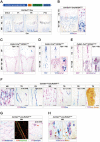Osteogenic fate of hypertrophic chondrocytes
- PMID: 25145361
- PMCID: PMC4185343
- DOI: 10.1038/cr.2014.111
Osteogenic fate of hypertrophic chondrocytes
Figures

Similar articles
-
A highly conserved enhancer in mammalian type X collagen genes drives high levels of tissue-specific expression in hypertrophic cartilage in vitro and in vivo.Matrix Biol. 2004 Aug;23(5):309-22. doi: 10.1016/j.matbio.2004.05.010. Matrix Biol. 2004. PMID: 15464363
-
BAC constructs in transgenic reporter mouse lines control efficient and specific LacZ expression in hypertrophic chondrocytes under the complete Col10a1 promoter.Histochem Cell Biol. 2007 Feb;127(2):183-94. doi: 10.1007/s00418-006-0236-8. Epub 2006 Oct 19. Histochem Cell Biol. 2007. PMID: 17051351 Free PMC article.
-
Tamoxifen-inducible gene deletion reveals a distinct cell type associated with trabecular bone, and direct regulation of PTHrP expression and chondrocyte morphology by Ihh in growth region cartilage.Dev Biol. 2007 Aug 1;308(1):93-105. doi: 10.1016/j.ydbio.2007.05.011. Epub 2007 May 18. Dev Biol. 2007. PMID: 17560974 Free PMC article.
-
Stimulation of type-X collagen gene transcription by retinoids occurs in part through the BMP signaling pathway.J Bone Joint Surg Am. 2003;85-A Suppl 3:29-33. doi: 10.2106/00004623-200300003-00006. J Bone Joint Surg Am. 2003. PMID: 12925606
-
Fate of growth plate hypertrophic chondrocytes: death or lineage extension?Dev Growth Differ. 2015 Feb;57(2):179-92. doi: 10.1111/dgd.12203. Epub 2015 Feb 24. Dev Growth Differ. 2015. PMID: 25714187 Review.
Cited by
-
Advances in Skeletal Dysplasia Genetics.Annu Rev Genomics Hum Genet. 2015;16:199-227. doi: 10.1146/annurev-genom-090314-045904. Epub 2015 Apr 22. Annu Rev Genomics Hum Genet. 2015. PMID: 25939055 Free PMC article. Review.
-
Dual pathways to endochondral osteoblasts: a novel chondrocyte-derived osteoprogenitor cell identified in hypertrophic cartilage.Biol Open. 2015 Apr 16;4(5):608-21. doi: 10.1242/bio.201411031. Biol Open. 2015. PMID: 25882555 Free PMC article.
-
Calcium-Sensing Receptors in Chondrocytes and Osteoblasts Are Required for Callus Maturation and Fracture Healing in Mice.J Bone Miner Res. 2020 Jan;35(1):143-154. doi: 10.1002/jbmr.3864. Epub 2019 Oct 18. J Bone Miner Res. 2020. PMID: 31498905 Free PMC article.
-
Fracture Healing in the Setting of Endocrine Diseases, Aging, and Cellular Senescence.Endocr Rev. 2022 Nov 25;43(6):984-1002. doi: 10.1210/endrev/bnac008. Endocr Rev. 2022. PMID: 35182420 Free PMC article. Review.
-
Wnt-associated adult stem cell marker Lgr6 is required for osteogenesis and fracture healing.Bone. 2023 Apr;169:116681. doi: 10.1016/j.bone.2023.116681. Epub 2023 Jan 25. Bone. 2023. PMID: 36708855 Free PMC article.
References
Publication types
MeSH terms
Substances
LinkOut - more resources
Full Text Sources
Other Literature Sources

